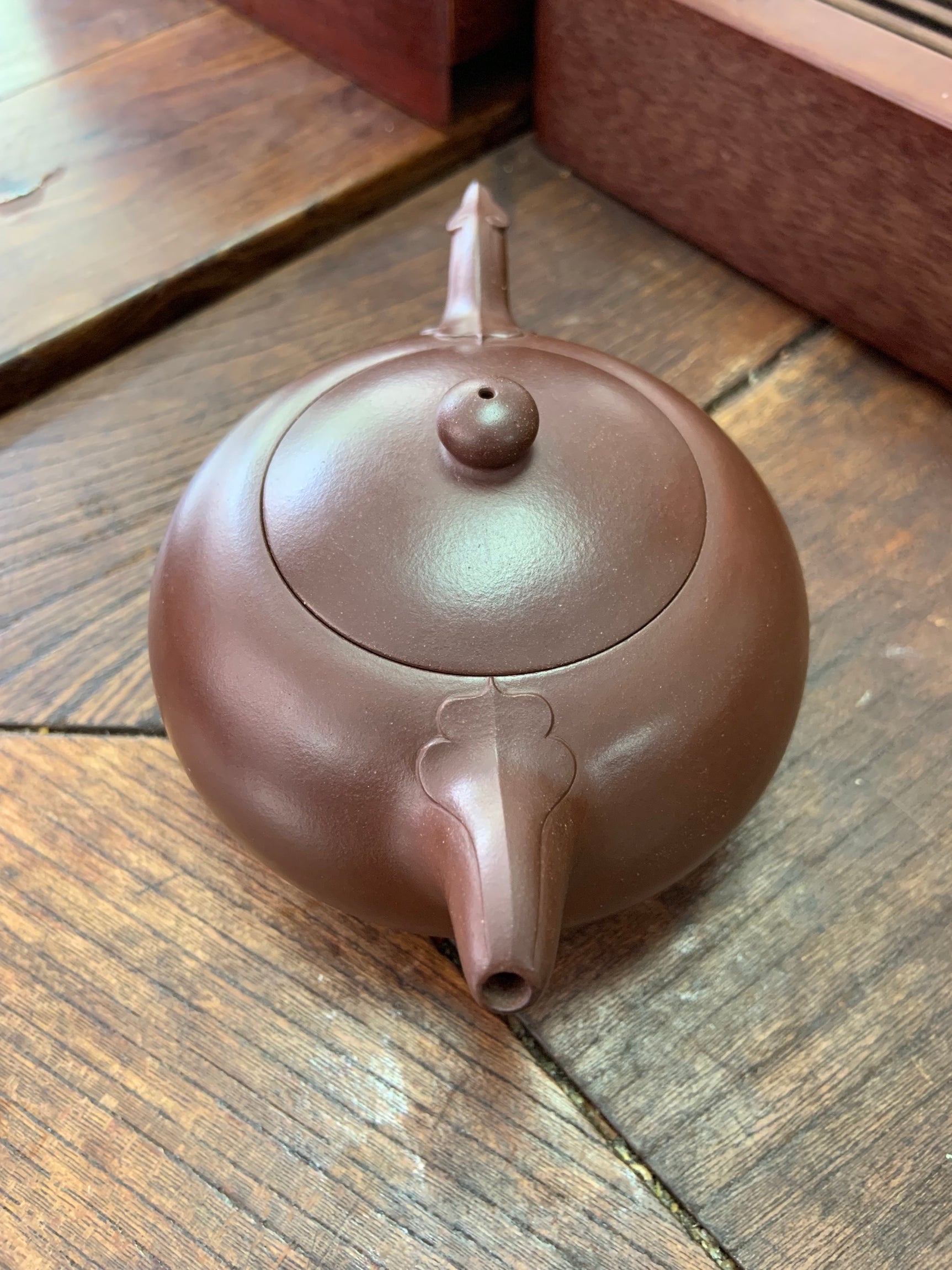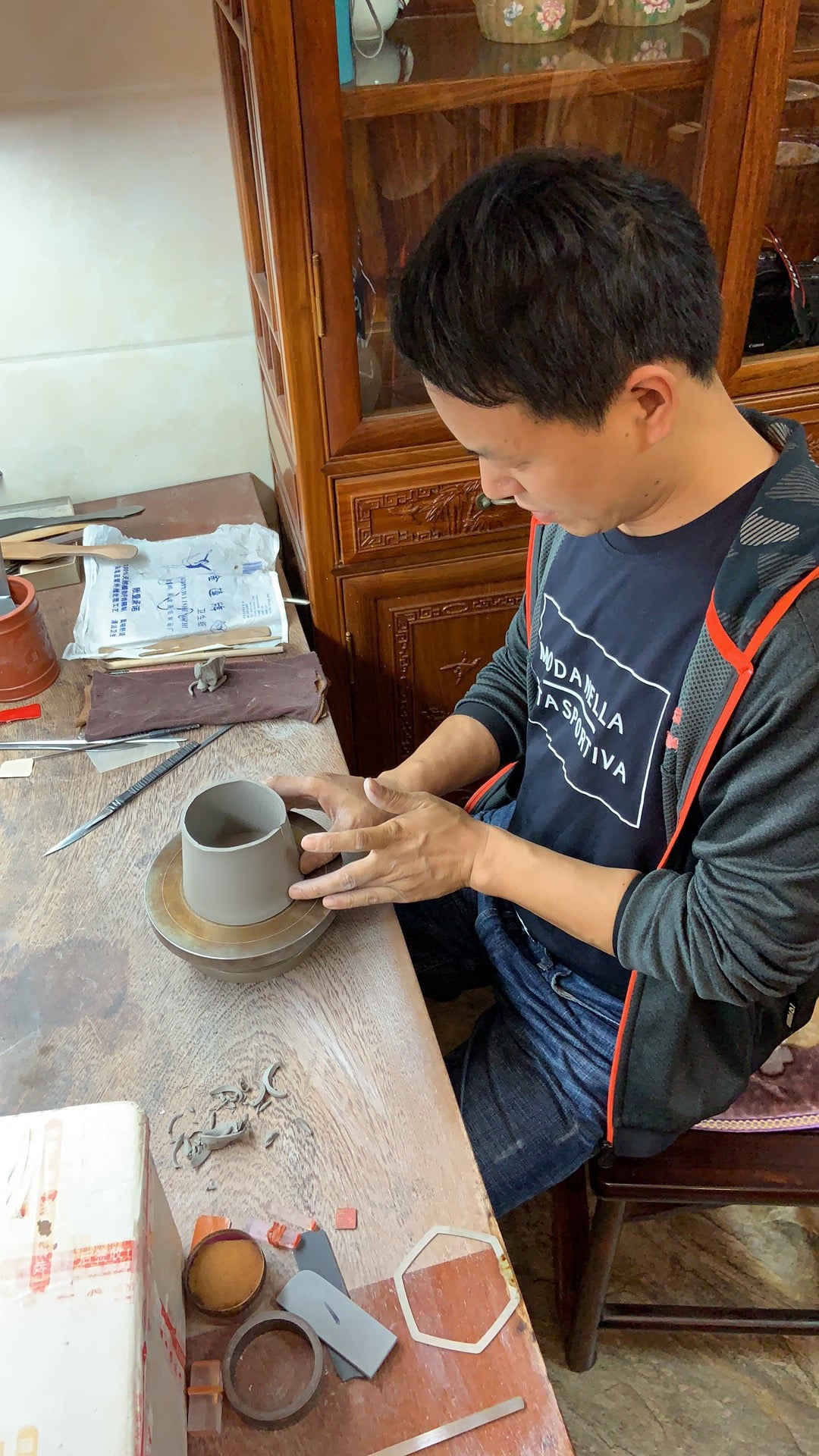Yixing and its stone-like teapots
30 April 2019
The tea tour is over, but I still have one more week to spend in China. I will visit Yixing and Jingdezhen, arguably the most renowned teaware cities in the country. The warehouse in Berlin is full of items waiting to be published on our online shop; no need to refill. So, for once, I will do a true vacation in China, travelling for my own sake rather than on Nannuoshan’s behalf. Plans, however, are made to change…
Upon my arrival I go straight to the shop of Mrs. Zhang, a Yixing potter. She made my favorite teapot, a sesame duanni pot that I use at home for Sheng Pu’er. Despite being the most expensive piece of my Yixing collection, it was made with the help of a mould and not by the more labor intense slab-building method. As far as Yixing is concerned, I prefer investing my money in the material rather than in the artistic effort of creating a pot by hand.
Mrs. Zhang brews a welcoming white tea in a pot identical to mine! It is her preferred brewing vessel for white and green teas.

Mrs. Zhang steeping white tea in “my” sesame duanni teapot.
Rarely is duanni as stone-like dense as in this teapot. I chose it for Shengpu as the hard clay doesn’t alter the taste of the leaves, just gently smoothes those sharp edges typical of some young Pu’ers. I also learned to appreciate the wide opening, as it simplifies introducing the long leaves of loose Pu’er and large chunks of bing cha.
We have 45 Yixing pots in the Berlin warehouse, so I shouldn’t really look for more here. But, well, I couldn't resist; now we have two teapots more in stock, as I just bought two sesame duanni.
After dinner, I visit the shop of one of our suppliers specialised in porcelain from Jingdezhen. I will go to Jingdezhen in a couple of days, but a visit to this shop has always been worthwhile in the past. Here as well, I end up buying teaware for Nannuoshan; a travel set, a teapot in a soft, pale sand hue with matching waste-water container, and a set of gongfu cha tools made of bamboo from close-by Anji.


A travel set was missing from Nannuoshan’s selection. Gaiwan, pitcher, and three cups all fit in a compact and safe case.


Teapot and waste-water container from Jingdezhen; bamboo gongfu cha tools from Anxi.
1 May 2019
In Dingshuzhen, a town just south of Yixing, everyone is in the pottery business. The streets are filled with teapot shops and studios; it would take weeks to just briefly enter each of them. More than any other ceramics, the material of the Yixing teapots is crucial for their brewing qualities. Good ore is rare, as the best mines have been closed years ago, and identifying good clay is not easy. A high-profitable business in which quality is hard to recognise attracts many; so relationship with reliable and honest suppliers shall be cultivated.
In the morning I visit two of our suppliers; the first one left the business to her daughter, a young lady that merged forces with her husband’s family, involved other friends, and transformed the company. I remember her mum alone in the shop, patiently carving a Gong Chun teapot (供春壺). Now, within the same walls, a dozen of friends in their early twenties run an online shop on Taobao, through which they sell every day many pots of dubious quality. Half of the shop was converted into a warehouse, a corner into a photo studio and along a wall three computers are lined up for simultaneous processing of online orders. Apparently, it is more profitable to sell low-quality teapots rather than spending time and resources in crafting them by hand using precious ore, as the mum was doing in the past. Luckily, last year, we sourced our pots from a new supplier, Mrs. Jiang, introduced by a mutual friend.

Teapot shops line up one next to another along this road, in the suburbs of Dingshuzhen.
Between 12 and 20 years ago, Mrs. Jiang bought large quantities of ore that she still stores close to the now closed mines. While steeping Pu’er in her shop, she explains how important the quality of the clay is to her, a topic that is not often deliberately mentioned by potters. I like her simple and unadorned teapots and end up buying a small, tall Zhuni that I will use for white tea or Fenghuang Dancong.
In the afternoon we visit the studio of Mrs. Lu, an artist warmly recommended by one of our tea suppliers. Mrs. Lu is famous. On the walls are pictures of Chinese VIPs holding her pots. She has been crafting teapots for more than thirty years! Her works are exposed in closed cabinets along the walls of the shop. Most of her teapots are heavily decorated and, at first glance, none attracts my attention. Her skills are notable and most shapes original; but I rather prefer simpler forms. My first opinion might also be influenced by the somewhat messy appearance of the shop/studio and her rough brewing techniques. My level of comfort increases after some cups of tea and having discovered that a person in the room speaks English. At a second, more careful look, three teapots emerge from the crowd, a pear-shaped zhuni, a zini, and a round, ashy pot. Their forms are lean but, most importantly, the clay has a metallic-stone appearance to both the eyes and touch. Caroline opts for the zhuni; she usually puts more emphasis on shape and dimensions than on material, but was entranced by the evident quality of this pot; it is the first time that she has seen Yixing clay of this level and can tell it apart from those seen in many other shops without my advice. I buy the black teapot, which is actually a zhuni mixed with wood ashes.
Of the three teapots, the zini is the most impressive. Probably not by chance, Mrs. Lu uses an exemplar of this pot to brew tea for us. I had never seen a zini of this quality before; in the hands, it is like holding a cast iron pot; it even feels as cold as metal. Thanks to our mutual friend, she offers us a great discount on all her teapots, almost one third of their price. Despite the good rate, I am hesitant. The zini still costs way more than the sesame duanni I bought yesterday; I could buy two round-trip flights to China with that money!



The red zhuni bought by Caroline, the black zhunu bought by me, and Mrs. Lu steeping tea in a fanatastic zini—I've never seen a zini-clay so stony and dense before.
2 May 2019
I wake up with the zini in mind and end up buying it few hours later. I haven’t decided yet whether to keep or to sell it; maybe I will put it online for a couple of months and, if no one buys it, I will understand that it was really meant to be mine.


My new zini!
Before taking a train to Jingdezhen there is still some time to visit a tea factory. Yixing Hong Cha, the local black tea, is not as famous as the teapots but deserves attention. It had been my breakfast tea for a while some years ago, but the last time I came to Yixing, none of the teas I tried convinced me.
The factory is next to the mountain; they fire the leaves of the best batches by hand in woks heated up with wood fire, not common for a factory of this size that would normally use electric heating and rolling machines; they even have organic certification! We try the tea on the spot but, unfortunately, they do not prepare it property, simply putting leaves in a glass and adding boiling water on top. Initially too hot and then overly brewed, it is difficult to evaluate the tea properly; anyway the price is too high for Nannuoshan. I take some samples home for later tasting.



Organic tea garden; the bushes have already been pruned as the harvest season is over.
Wok for firing the best batches of leaves for black tea (look at the oxidised copper fur in the woks, hair shed from the buds. The wood-fired caldron behind the wall.
We bought sooo many teapots in these few days that there is no space in the backpack to carry them on the journey. We send a parcel to Shanghai, and will collect them before flying back home.
Written by Gabriele











